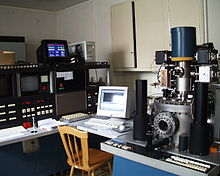4:55 AM
hi TK nice. you should mention it on the math blog chat room. they'll probably like it. did you know semigroups have a strong almost 1-1 connection with finite state machines?
we follow some of the same blogs. really like rjliptons blog, have commented a lot on it over long period.
what are you doing in the semiconductor industry? fascinating field. have a huge pile of links on that am waiting to write up sometime-or-other. also, just watched a documentary on Silicon Valley/ phillip noyce less than a week ago, really great stuff, very inspiring.

Robert Norton Noyce (December 12, 1927 – June 3, 1990), nicknamed "the Mayor of Silicon Valley," co-founded Fairchild Semiconductor in 1957 and Intel Corporation in 1968. He is also credited (along with Jack Kilby) with the realization of the first integrated circuit or microchip which fueled the personal computer revolution and gave Silicon Valley its name.
== Biography ==
Active all his life, Noyce enjoyed reading Hemingway, flying his own airplane, hang gliding, and scuba diving. Noyce believed that microelectronics would continue to advance in complexity and sophistication well beyond...
5:24 AM
5:38 AM
The connections between finite state machines and semigroups I know are [recognizable set](http://en.wikipedia.org/wiki/Recognizable_set),
[rational set](http://en.wikipedia.org/wiki/Rational_set),
[regular language](http://en.wikipedia.org/wiki/Regular_language)
http://en.wikipedia.org/wiki/Krohn–Rhodes_theory
[rational set](http://en.wikipedia.org/wiki/Rational_set),
[regular language](http://en.wikipedia.org/wiki/Regular_language)
http://en.wikipedia.org/wiki/Krohn–Rhodes_theory
In computer science, more precisely in automata theory, a recognizable set of a monoid is a submonoid that can be mapped in a certain sense to some finite monoid through some morphism. Recognizable sets are useful in automata theory, formal languages and algebra.
This notion is different from the notion of recognizable language. Indeed, the term "recognizable" has a different meaning in computability theory.
== Definition ==
Let be a monoid, a submonoid is recognized by a monoid if there exists a morphism from to such that , and recognizable if it is recognized by some finite monoid. This...
In computer science, more precisely in automata theory, a rational set of a monoid is an element of the minimal class of subsets of this monoid which contains all finite subsets and is closed under union, product and Kleene star. Rational sets are useful in automata theory, formal languages and algebra.
A rational set generalizes the notion of rational (regular) language (understood as defined by regular expressions) to monoids that are not necessarily free.
== Definition ==
Let be a monoid. The set of rational subsets of is the smallest set that contains every finite set and is closed under...

In theoretical computer science and formal language theory, a regular language (also called a rational language) is a formal language that can be expressed using a regular expression, in the strict sense of the latter notion used in theoretical computer science. (Many regular expressions engines provided by modern programming languages are augmented with features that allow recognition of languages that can not be expressed by a classic regular expression.)
Alternatively, a regular language can be defined as a language recognized by a finite automaton. The equivalence of regular expressions and...
In mathematics and computer science, the Krohn–Rhodes theory (or algebraic automata theory) is an approach to the study of finite semigroups and automata that seeks to decompose them in terms of elementary components. These components correspond to finite aperiodic semigroups and finite simple groups that are combined together in a feedback-free manner (called a "wreath product" or "cascade").
Krohn and Rhodes found a general decomposition for finite automata. In doing their research, though, the authors discovered and proved an unexpected major result in finite semigroup theory, revealing a deep...
5:53 AM
@vzn Arnold Neumaier's observation of the connection between partial coherence in optics and quantum mechanics are not a "local hidden variable" model. They are rather a situation where expectation values occur without a corresponding frequentist interpretation. In other writings, Neumaier points out that probability theory has indeed an interpretation just based on expectation values without recourse to frequencies.
@vzn The semiconductor "manufacturing" industry is concerned with manufacturing "small" structures...

Photolithography, also termed optical lithography or UV lithography, is a process used in microfabrication to pattern parts of a thin film or the bulk of a substrate. It uses light to transfer a geometric pattern from a photomask to a light-sensitive chemical "photoresist", or simply "resist," on the substrate. A series of chemical treatments then either engraves the exposure pattern into, or enables deposition of a new material in the desired pattern upon, the material underneath the photo resist. For example, in complex integrated circuits, a modern CMOS wafer will go through the photolithographic...

Extreme ultraviolet lithography (also known as EUV or EUVL) is a next-generation lithography technology using an extreme ultraviolet (EUV) wavelength, currently expected to be 13.5 nm.
== EUVL light source ==
Neutral atoms or condensed matter cannot emit EUV radiation. For matter to emit it, ionization must take place first. EUV light can only be emitted by electrons which are bound to multicharged positive ions; for example, to remove an electron from a +3 charged carbon ion (three electrons already removed) requires about 65 eV. Such electrons are more tightly bound than typical valence electrons...

Electron-beam lithography (often abbreviated as e-beam lithography) is the practice of scanning a focused beam of electrons to draw custom shapes on a surface covered with an electron-sensitive film called a resist ("exposing"). The electron beam changes the solubility of the resist, enabling selective removal of either the exposed or non-exposed regions of the resist by immersing it in a solvent ("developing"). The purpose, as with photolithography, is to create very small structures in the resist that can subsequently be transferred to the substrate material, often by etching.
The primary advantage...
6:40 AM

Multiple patterning is a class of technologies for manufacturing integrated circuits (ICs), developed for photolithography to enhance the feature density. The simplest case of multiple patterning is double patterning, where a conventional lithography process is enhanced to produce double the expected number of features. The resolution of a photoresist pattern begins to blur at around 45 nm half-pitch. For the semiconductor industry, therefore, double patterning was introduced for the 32 nm half-pitch node and below, mainly using state-of-the-art 193 nm immersion lithography tools.
There are several...
9 hours later…
4:05 PM
29
My impression is that, by and large, traditional algebra is rather too specific for use in Computer Science. So Computer Scientists either use weaker (and, hence, more general) structures, or generalize the traditional structures so that they can fit them to their needs. We also use category th...
5:08 PM
neumaiers correspondence is more like saying that when your optical problem is equivalent to solving the Helmholtz equation, then you could observe a similar acoustic problem, which is also equivalent to solving the Helmholtz equation
In neumaier's model, saying which measurements are allowed and what constitutes a measurement is no easier than in quantum mechanics itself. But you are still in a setup where you can understand everything, and know why it happens, even if second order statistical optics is not really that simple to understand either.
5:56 PM
6:52 PM
1 hour later…
7:59 PM
I'm don't think that Neumaier sees it that way. The Copenhagen interpretation is not commited to quantum mechanics being not-understandable. Whether probability has to be interpreted strictly in frequentist terms is debatable, but if yes, then QM can never describe the evolution of the universe, because you can't repeat that experiment as required for the frequentist interpretation.
8:11 PM
8:25 PM
I just tried to make an analogy in classical physics. The analogy here is that the 2D transversal electric Maxwell-equations are equivalent to a normal 2D Helmholtz equation, and hence to a 2D acoustic equation. Similarly, Neumaiers models show exact correspondence between certain special cases of quantum systems (only one/two particles, if I remember correctly) and second order statistical optics.
9:18 PM
9:38 PM
« first day (529 days earlier) ← previous day next day → last day (3100 days later) »
Transcript for
Dec9
Dec '1410
Dec11
 theory salon
theory salon
theoretical computer science. highlight reel vzn1.wordpress.co...
